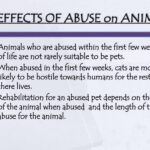The issue of animal cruelty is one that has garnered significant attention in recent decades. From incidents of neglect to overt acts of violence against animals, the legal frameworks in place to combat such injustices vary markedly across different jurisdictions. This article will explore the myriad laws addressing animal cruelty within the United States and beyond, examining their types, effectiveness, and evolving nature in response to changing societal attitudes.
Animal cruelty laws can be broadly classified into two categories: criminal laws and civil laws. Criminal laws serve to penalize individuals who engage in acts of cruelty against animals, typically by imposing fines or imprisonment. Civil laws, on the other hand, may include provisions that allow for the restitution of damaged property or the establishment of animal rights in certain contexts.
In the United States, every state has enacted some form of animal cruelty legislation. These laws are frequently categorized as either anti-cruelty statutes or neglect laws. Anti-cruelty statutes target intentional acts of cruelty, such as beating, torturing, or otherwise harming animals. Conversely, neglect laws typically concern the failure to provide adequate care, sustenance, or shelter for animals in one’s care.
To illustrate the divergence in state-specific regulations, consider the anti-cruelty legislation in California. Under the California Penal Code, violations can lead to felony charges, which may incur severe penalties, including imprisonment and significant fines. Other states, however, may treat similar infractions with a lesser degree of severity, categorizing them as misdemeanors. Such disparities underscore the need for a harmonized legal approach across the nation, which could bolster protections for animals everywhere.
The concept of animal standing—a legal principle granting animals the right to sue—has emerged in various jurisdictions, further shaping the landscape of animal welfare laws. While not universally accepted, some courts have begun to recognize the need for animals to be seen as more than mere property. In certain instances, this has led to precedent-setting judgments that affirm the rights of animals in various legal contexts.
Internationally, animal cruelty laws exhibit considerable variation. Countries like Germany and Switzerland have adopted comprehensive statutes that prioritize animal welfare as a fundamental principle. German law, for instance, explicitly recognizes animals as sentient beings, placing the onus on individuals and society to treat them with respect and care. In stark contrast, many developing nations lack formal regulations, relying instead on cultural practices or informal societal norms to govern the treatment of animals. This inconsistency raises ethical questions regarding the global approach to animal rights and welfare.
Legislative progress has been achieved through the establishment of pivotal laws such as the Animal Welfare Act (AWA) in the United States. This federal statute sets minimum standards for the treatment of animals used in research, exhibition, and transport. While a laudable effort, the AWA has notable limitations, such as its exclusion of farm animals and animals used in fashion, leaving considerable gaps in protection. Consequently, many advocacy groups are campaigning for the expansion of this legislation to ensure comprehensive coverage for a wider array of animal species.
In recent years, there has been a marked increase in public awareness and concern over animal cruelty, propelled by social media and advocacy campaigns. Grassroots organizations are increasingly empowered to lobby for stricter laws, prompting legislatures to reconsider outdated statutes. Such movements are visible not only in the United States but also globally, as activists unite across borders to fight for animal rights.
The evolution of technology plays a pivotal role in the fight against animal cruelty. Surveillance devices and body cameras are now commonplace in farms and kennels, enabling the documentation of unethical practices. By capturing evidence of maltreatment, these tools strengthen cases brought against offenders. Additionally, the rise of internet-based platforms has transformed how information is disseminated, empowering citizens to report suspected animal abuse more readily. This heightened transparency drives accountability and fosters a culture of vigilance against cruelty.
Within the legislative sphere, there has also been a burgeoning interest in the establishment of “animal courts” designed to handle cases of animal cruelty specifically. This innovative approach seeks to create specialized judicial bodies that would focus on animal welfare matters, ensuring that such cases receive the dedicated attention they deserve. The introduction of animal courts could lead to more informed rulings and more appropriate penalties for offenders.
Perhaps the most significant legislative momentum can be seen in the establishment of “ag-gag” laws, which seek to criminalize the act of documenting animal abuse in agricultural settings. While proponents claim that these laws protect the privacy and livelihood of farmers, critics argue they are inherently unjust and serve to shield cruelty from public scrutiny. Thus, the dialogue surrounding these laws is illustrative of the current tensions in animal welfare legislative efforts—an intersection of ethics, economics, and public policy.
In conclusion, the landscape of animal cruelty laws is dynamic and evolving. The patchwork of statutes across the United States and internationally reflects cultural attitudes towards animals, societal values, and awareness of animal rights. As knowledge grows and societal norms shift, there is hope that legal protections for animals will continue to deepen. Advocacy efforts continue to be vital in pushing forward reforms that transcend jurisdictional boundaries, fostering a future where animals are afforded the respect and dignity they undoubtedly deserve.







